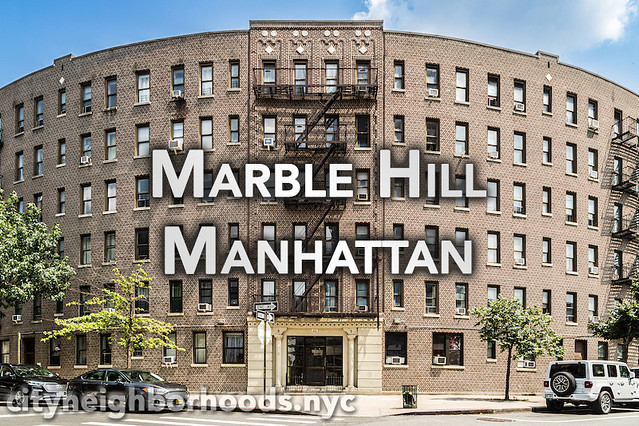Mobile users, you may need to rotate your device or click the + sign above to see the full list of neighborhoods.
MArble Hill - Manhattan - NYC
Marble Hill is a unique neighborhood in New York City. Although it is part of the borough of Manhattan, it is not located on the island of Manhattan. Instead, Marble Hill is on the mainland, surrounded by neighborhoods of The Bronx. It is flanked by Spuyten Duyvil to the west and Kingsbridge Heights to the east. Kingsbridge is to the north while Sputyen Duyvil Creek separates it from is siblings on the island of Manhattan.
Marble Hill slideshow (Coming Soon)
The Neighborhood
The history of Marble Hill is a fascinating tale of urban development, engineering projects, and the evolution of a neighborhood's identity. Situated in the northern part of Manhattan, Marble Hill's history is closely tied to changes in the landscape and the city's growth over the centuries.
Marble Hill's story begins in the 17th century when the area was inhabited by the Lenape Native American tribe. Dutch settlers later established a trading post in the region, utilizing the Harlem River's waterways for transportation and trade. The name "Marble Hill" derives from the deposits of marble found in the area, which were quarried and used in the construction of notable buildings, including St. John's Episcopal Church in Manhattan.
The transformation of Marble Hill into a neighborhood, however, is closely linked to the development of transportation infrastructure in the 19th century. With the advent of the Harlem Ship Canal project in the late 19th century, the Harlem River was rerouted to create a navigable waterway, effectively turning the high ground of Marble Hill into an island. While this engineering feat was intended to improve navigation and industrial transport, it also had unintended consequences for the neighborhood's geographical and administrative status.
As a result of the canal project, Marble Hill became physically cut off from the Bronx, to which it had been attached. However, due to the way administrative boundaries were defined, the neighborhood remained legally a part of the Bronx. This peculiar situation created confusion about whether Marble Hill should be considered part of Manhattan or the Bronx, a debate that continues to this day.
Over the years, Marble Hill evolved into a residential area with a mix of housing, including tenement buildings, apartment complexes, and single-family homes. Its location near the Harlem River and its hilly terrain made it an attractive place to live for those seeking a quieter and more suburban-like environment within the city.
Transportation has played a crucial role in shaping Marble Hill's history. The neighborhood's accessibility improved with the extension of the 1 train, which provided direct subway connections to Manhattan and other parts of the city. This connection has been a lifeline for Marble Hill residents, allowing them to easily access the rest of New York City while enjoying the neighborhood's more tranquil atmosphere.
In recent years, efforts have been made to address the challenges and opportunities presented by Marble Hill's unique geographical situation. The neighborhood's infrastructure, parks, and community services have seen improvements, helping to foster a stronger sense of community and connection among its residents.
In essence, Marble Hill's history is one of transformation and adaptation. From its origins as a marble-rich area to its role in shaping New York City's transportation landscape, the neighborhood's story is a testament to the dynamic nature of urban development and the resilience of communities in the face of change.
Marble Hill Highlight Gallery
Click here for the full Marble Hill photo gallery:
Explore Every New York City Neighborhood:
All photography provided by Samuel Walters



